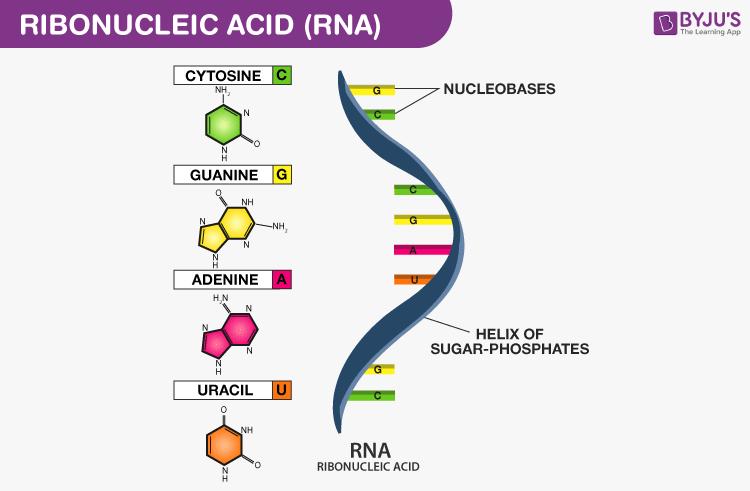
Ribonucleic acid, or RNA, is a multifaceted and pivotal molecule in the realm of molecular biology. While it often plays second fiddle to its more famous cousin, DNA, RNA’s importance in the cellular orchestra cannot be overstated. This comprehensive article takes you on a journey through the world of RNA, exploring its structure, types, functions, and the profound impact it has on life as we know it.
The Structure of RNA
RNA, like DNA, is composed of nucleotides. Each nucleotide consists of three components:
- A phosphate group (PO4): This provides a negative charge and connects nucleotides together.
- A ribose sugar: Unlike DNA, which contains deoxyribose sugar, RNA contains ribose sugar, which has one more oxygen atom.
- A nitrogenous base: RNA uses four bases: adenine (A), cytosine (C), guanine (G), and uracil (U). Uracil replaces thymine (T) found in DNA.
These nucleotides are linked together in a linear fashion to form an RNA strand, which can be single-stranded or partially double-stranded, depending on the type of RNA.
Types of RNA
There are several types of RNA, each with distinct roles in the cell:
1. Messenger RNA (mRNA)
mRNA is a temporary copy of a gene’s instructions for making a protein. It carries the genetic code from the DNA in the nucleus to the ribosomes in the cytoplasm, where protein synthesis occurs.
2. Ribosomal RNA (rRNA)
rRNA is a structural component of ribosomes, the cellular machinery responsible for protein synthesis. Ribosomes consist of both rRNA and proteins and function as the site of protein assembly.
3. Transfer RNA (tRNA)
tRNA acts as an adaptor molecule during protein synthesis. It carries amino acids to the ribosome, where they are matched with the appropriate codons on the mRNA strand. This process ensures that the correct amino acids are used to build the protein.
4. Small Nuclear RNA (snRNA)
snRNA plays a crucial role in the processing of pre-mRNA (the initial transcript of a gene) into mature mRNA. It is involved in removing introns (non-coding regions) and splicing together exons (coding regions) to create the final mRNA molecule.
5. Small Nucleolar RNA (snoRNA)
snoRNA is found in the nucleolus and is involved in modifying and processing rRNA. It helps in the formation of functional ribosomes.
6. MicroRNA (miRNA) and Small Interfering RNA (siRNA)
These small RNA molecules are involved in regulating gene expression by binding to specific mRNA molecules, preventing their translation into proteins. They play a significant role in post-transcriptional gene regulation.
Functions of RNA
RNA serves a wide array of functions within the cell:
1. Protein Synthesis
One of the most critical roles of RNA is in protein synthesis. mRNA carries the genetic information from DNA to the ribosomes, where rRNA and tRNA work together to translate this information into functional proteins.
2. Gene Regulation
Small RNAs like miRNA and siRNA are key players in gene regulation. They can silence or degrade specific mRNA molecules, thus controlling the levels of certain proteins in the cell.
3. Catalysis
Some RNA molecules, known as ribozymes, have catalytic activity, meaning they can accelerate chemical reactions within the cell. This catalytic property of RNA challenges the long-held belief that only proteins could act as enzymes.
4. Telomerase
RNA is an integral part of the enzyme telomerase, which is responsible for maintaining the length of telomeres at the ends of chromosomes. Telomeres play a crucial role in cellular aging and division.
5. Immune Response
RNA is involved in the immune response to viral infections. The cell recognizes viral RNA as foreign, triggering a series of defense mechanisms to combat the infection.
The RNA World Hypothesis
The significance of RNA goes beyond its roles in contemporary biology. The RNA world hypothesis suggests that, in the early stages of life on Earth, RNA may have served as both genetic material and catalytic molecules, predating DNA and proteins. This idea has profound implications for our understanding of the origin of life.
Conclusion
RNA, often overshadowed by its famous relative DNA, is a molecular workhorse essential for life. From guiding protein synthesis to regulating gene expression and even catalyzing chemical reactions, RNA is a versatile molecule with diverse functions. Our understanding of RNA continues to evolve, shedding light on both its pivotal role in modern biology and its potential significance in the origins of life itself. As we delve deeper into the intricate world of molecular biology, RNA remains an unsung hero, quietly orchestrating the symphony of life within our cells.



